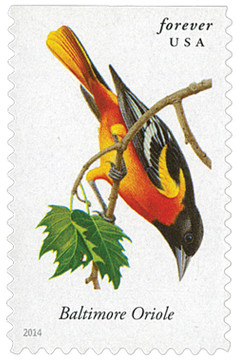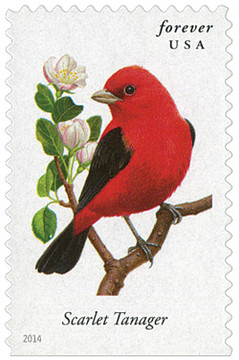
US #4887
2014 Evening Grosbeak – Songbirds
- Pictures an evening grosbeak
- One of 10 stamps picturing different species of songbird
Stamp Category: Commemorative
Set: Songbirds
Value: 49¢ First Class Mail Rate (Forever)
First Day of Issue: April 5, 2014
First Day City: Dallas, Texas
Quantity Issued: 400,000,000
Printed by: Ashton Potter (USA) Ltd.
Printing Method: Offset
Format: Double-sided Booklets of 20
Tagging: Nonphosphored Type III, Overall Tagged
Why the stamp was issued: To commemorate the evening grosbeak and its unique song.
About the stamp design: Pictures a painting of an evening grosbeak perched on a snowy conifer tree branch. Artwork by Robert Giusti. The stamp also includes the species’ common name.
First Day City: In addition to the Dallas, Texas, First Day of Issue city, there was also a First Day of Sale ceremony held at the Philadelphia National Stamp Exposition in Oaks, Pennsylvania. They offered two different pictorial postmarks: one from Oaks and one from nearby Audubon, Pennsylvania. The pictorial cancels were designed by the American First Day Cover Society.
About the Songbirds set: Issued to commemorate the many species of songbirds that call America home and fill the air with the sounds of their unique tunes. Includes 10 different designs, each picturing a different species of songbird and its’ common name: western meadowlark, mountain bluebird, western tanager, painted bunting, Baltimore oriole, evening grosbeak, scarlet tanager, rose-breasted grosbeak, American goldfinch, and white-throated sparrow. In addition to the birds themselves, the stamps also picture different plants (often found in the birds’ natural habitats) acting as perches. Designs were created from paintings by Robert Giusti.
History the stamp represents: The evening grosbeak is a rather round, black and yellow songbird in the finch family. It is a nonaggressive, social bird often seen foraging in noisy flocks throughout the year.
Like most finches, the evening grosbeak is a skillful seed cracker, and its winter diet consists mainly of seeds. It lives in the coniferous mountain forests of the western United States and the northern forests of Canada, where such seeds are plentiful.
Known as a “nomadic winter migrant,” this grosbeak leaves its nesting area only when necessary to find food. Sometimes, it will simply migrate to lower elevations, but it has been known to winter throughout the northern United States and even as far south as Mexico.
During the summer months, the bird will supplement its seed diet with small insects. Its particular favorite is spruce budworm larvae, a serious pest in North American seed-bearing forests. A budworm outbreak can often be predicted by the increased number of evening grosbeaks.
Ironically, the evening grosbeak does not have much of a “song” for a songbird. It projects sweet yet simple chirps, calls, and warbles, but unlike other songbird species, the evening grosbeak offers no distinct recognizable song.















